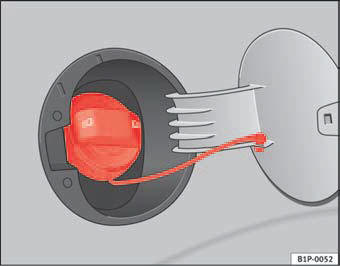Seat Leon >> Refuelling
The fuel cap cover opens automatically with the central locking system. The tank holds approximately 55 litres.

Fig. 140 Tank flap open
Unscrewing the tank cap
– Lift the lid.
– Unscrew the cap, turning it anti-clockwise.
Closing the tank cap
– Screw the tank cap to the right, until the point of feeling a “click”.
– Close the drawer. Make sure you hear it click into place. The tank
cap is secured with an anti-loss attachment
The tank flap is at the rear of the vehicle on the right.
If the automatic filler nozzle is operated correctly, it will switch itself off as soon as the tank is “full”. Never attempt to fill beyond this point, as this will fill the expansion chamber. Fuel may leak out if ambient conditions are warm.
The correct fuel grade for your vehicle is given on a sticker on the inside of the fuel tank flap, where further notes on fuel can be found.
Releasing the fuel tank flap by hand
If the central locking system fails, the fuel tank flap can be opened manually
as follows:
• Open the tailgate
• Remove the cover from the right side trim in the luggage compartment.
• Insert a hand and pull the locking device back
• Open the cap and take out the plug.
WARNING
• Fuel is highly inflammable and can cause serious burns and other
injuries.
− Never smoke or use any naked flame when filling the fuel tank of the
vehicle, or a spare fuel canister, with fuel. This is an explosion hazard.
− Follow legal requirements for the use of spare fuel canisters.
− For safety reasons we do not recommend carrying a spare fuel
canister in the vehicle. The canister could be damaged in an accident
and leak.
• If, in exceptional circumstances, you have to carry a spare fuel canister,
please observe the following points:
− Never fill the spare fuel canister inside the vehicle or on it. An
electrostatic
charge could build up during filling, causing the fuel fumes to
ignite. This may be fatally explosive. Always place the canister on the
ground to fill it.
− Insert the fuel nozzle into the mouth of the canister as far as
possible.
− If the spare fuel canister is made of metal, the filling nozzle must be
in contact with the canister during filling. This helps prevent an electrostatic
charge building up.
− Never spill fuel in the vehicle or in the luggage compartment. Fuel
vapours are explosive. Danger of death.
Caution
• Fuel spills should be removed from the paintwork immediately.
• Never run the tank completely dry. An irregular fuel supply could cause
misfiring. As a result, unburnt fuel could enter the catalytic converter and
cause damage.
For the sake of the environment
Do not try to put in more fuel after the automatic filler nozzle has switched
off;
this may cause the fuel to overflow if it becomes warm.
 Petrol
Petrol
...
See also:
Wheel securing bolts: Tighten to specified
torque
At the delivery inspection
Loosen / tighten the anti-theft wheel bolts
Tightening wheel bolts
Install wheel centre trim, wheel bolt cover caps and wheel
cover
Loosen / tighten the anti-th ...

